Dnieguan Armed Forces
This article is incomplete because it is pending further input from participants, or it is a work-in-progress by one author. Please comment on this article's talk page to share your input, comments and questions. Note: To contribute to this article, you may need to seek help from the author(s) of this page. |
| Dnieguan Armed Forces | |
|---|---|
| Gemmestnah Koalitiony av Manvatnikov od Dnieguiya Гемместнах Коалитионы ав Манватников од Дниегуиыа | |
| File:Cossack Arms.png Coat of Arms of the Dnieguan Armed Forces | |
| Founded | February 16th 1302 |
| Service branches | Dnieguan Army Dnieguan Navy Dnieguan Air Force Dnieguan Naval Infantry Dniguan Air-Landing forces |
| Leadership | |
| Commander-in-Chief | Petr Venevitinov |
| Hetman-General | Gen. Bogdan Razumtsky |
| Chief of the General Staff | Gen. Vidar Fyodorovich |
| Manpower | |
| Military age | 17 years of age |
| Conscription | Males finishing secondary school must serve 24 months (Or 36, depending on selected service) |
| Available for military service | 16,250,000 males (2010 est.) 16,000,000 females (2010 est.), age 15–49 |
| Fit for military service | 12,000,000 females (2010 est.) 11,500,000 females (2010 est.), age 15–49 |
| Reaching military age annually | 450,000 males (2012 est.) 400,000 females (2012 est.) |
| Active personnel | 728,000 personnel |
| Reserve personnel | 1,875,685 reserve personnel |
| Expenditures | |
| Budget | $213,737,066,880(2015) |
| Percent of GDP | 4% (2015) |
The Armed Forces of Dniegua (Dnieguan: Gemmestnah Koalitiony av Manvatnikov od Dnieguiya) is the Federal Military forces of the nation of Dniegua. Comprised of the Army, Air Force, Navy, Naval Infantry and Air-Landing forces. Dniegua has a strong military tradition, wherein in midevil times, much of the tribes that eventually made up Dniegua had strong martial traditions. It has been said that for Dnieguan people, Military service is a way of life. The Armed Forces are controlled by the Commander-in-Cheif, the current Hetman of Dniegua, Petr Venevitinov. Leadership is controlled by the Hetman-General, Gen. Bogdan Razumtsky, while the commander of operations, the Chief of the General Staff, Gen. Vidar Fyodorovich, coordinates battle and humanitarian operational decisions. From the earliest days, the Military of Dniegua has been a vital part of Dnieguan history, and permeates many sectors of society.
The formal founding date of the current incarnation of the Dnieguan military is officially 16 Febuary 1302 when Hetman Garmin II formally created both the Army and Navy by royal decree. However, the Hetmanate Army traces its origins back to the original standing Cossack Hoards of the 8th-4th century BC. Having gone through many versions in its life, the Dnieguan military draws culture and inspirations from a number of backgrounds, and is diverse in both tradition and styles.
History
The official history of the Dnieguan Armed Forces dates to sometime around 600 BCE, though it is likely that military history predates even that; the earliest recorded history concerning the tribes that occupied Dniegua simply dates from this era. The Dnieguan people by and large have always been a marshal culture, constantly in a state of conflict with one another in the earliest eras of civilization.
Throughout much of the 18th, 19th and 20th century, Dniegua was involved in a series of long, violent and bloody wars throughout the Skandera continent with neighboring Temuair, Gratislavia. Sieuxerr, Estovinia and Austrasien. The so called "bloody years" saw over 45 wars fought in a 250 year period, with Dniegua having forces involved in nearly all them, principally due to former Hetmans policies of military sales, wherein units were available for "rent" to foreign nations for significant prices. These prices often were in order, however; the average Cossack soldier was expected to be far more experienced than his contemporary equal, and far more willing to fight.
Dniegua played an active role in the Second Skandar War, participating in combat operations against neighboring Gratislavia, resulting in significant gains and losses on various fronts.
In 2015, the Dnieguan Armed Forces, mostly the Navy and Airforce, launched Operation: Cointoss, the Dnieguan invasion and pacification of neighboring Gratislavia during the 2015 Royalist uprising.
Branches
Army
Main Article: Dnieguan Army
The Dnieguan Army, or Land Force, is the primary land-arm of the Dnieguan Armed Forces. Encompassing forces whos express purpose it is to conduct combat or peacekeeping operations on land, the Dnieguan Army contains the highest amount of Conscripts in the armed forces as a percentile. The Army is organized into units called brigyads, while the Homeguard, a national Gendarme like force, organize themselves into localized battalion sized formations. The Army maintains 6 foreign deployment bases, three of which are located outside of Skandera.
Main Article: Dnieguan Navy
Main Article: Dnieguan Naval Infantry
The Dnieguan Royal Navy is the sea-arm of Dniegua. The Naval Infantry are a subordinate sea-born military force of the Navy, which exists as the Dnieguan Navy's principal maritime landing and expeditionary force. The Dnieguan Naval Infantry maintain their own inventory of aircraft, a small number of patrol ships, and infantry forces. The Navy is organized into territorial defense and external deployment forces, and maintains trong presence in waters around Skandera.
Airforce
Main Article: Dnieguan Airforce
The Dnieguan Air Force is the air-arm of Dniegua. The airforce contains the lowest number of personnel (Besides the Naval Infantry) in the Dnieguan Military, but receives only 5% less funding than the Navy. Consisting of some 800 combat aircraft, the Dnieguan airforce has long placed high emphasis on sophisticated dedicated role aircraft and low maintenance multi role fighter aircraft.
Homeguard
The Dnieguan Homeguard is a national security force that encompass reserves and volunteers. Based on a local level, the Homeguard acts as security providers, disaster relief, police reserves and local public works laborers for various jobs. A typical homeguard unit is based goegrapically and organized into regional commands at the Battalion level. Smaller townships may have a single homeguard unit spread over several hundred square kilometers; larger metros have homeguard units ranging from two battalions to full strength brigades in major cities. In smaller settings, Post offices or government buildings also act as the Homeguard armory and motor pool, where several vehicles and heavier equipment are located.
Doctrine and Tactics
Mission Statement
The sated mission of the Dnieguan Armed Forces is "To provide safety and security to the homeland and provide peace of mind to the people of [The Kingdom] from threats, both foreign and domestic, at home and abroad".
Tactics
The Dnieguan Military has long been pioneering force of military tactics. The first nation to have a Naval Infantry force, the Dnieguan Armed Forces also pioneered many aspects of modern military combat, including rapid fire artillery pieces, cavalry units, Snipers, and has influenced unit organizations for long periods of time. On the Skanderan continent, the soldiers of Dniegua long have fought in foreign wars.
Historical Tactics
Early Dnieguan tactics focused mostly on line infantry armed with pikes and spears forming major lines, fronted by Skalvmort, a warrior class notable for their stout size and strong build. These warriors normally were armed with heavy shields and clubs and acted as mobile cover for the pike and spearmen. The line infantrymen were to provide initial assault forces, which would then be stormed by the advanced and professional Cossack cavalry. If possible, Dnieguan commanders often preferred to screen enemy forces with Cossack Light Archers, whom were able to strike man-sized targets at full gallop with their curved bows.
With the advent of gunpowder, the Dnieguan forces quickly adopted musketeers and riflemen, and demonstrated significant success with these units, as well as pistol cavalry, whom often rode into battle with as many as 26 loaded pistols, in addition to a saber. However, slow to adopt large artillery pieces, they soon fount their inability to fire significant amounts of large ordinance at long range detrimental to their war efforts.
With industrialization, the Dnieguan military found itself engaged more often in new wars against its neighbors. The invention of long range artillery and the quik adoption of said artillery by Dniegua provided the armed forces with the advantage of manuverable firepower, which blended extreemly well with the cavalry ccentric infantry arms. Large fortifications were build throughout the country along the borders to bombard likely avenues of advance from neighboring nations, many of which stand today.
Modern Tactics
The Dnieguan Armed Forces maintain a significant amount of power projection comparative to population size, mostly due to Hemvärnost, the Dnieguan militant culture that permeates society.
Land Forces Base Scheme
The modern Dnieguan military is largely mechanized, with limited special warfare units and a number of regional defensive units remaining as light infantry. With this mechanization, Dniegua has split its forces into two distinctive forms of mechanized units; Tarskiv (Sometimes called Parsari), Armored, and Motoradlki, motorized. These terms derive mostly from the status of armored vehicles within the individual unit. A Tarskiv unit consists mostly of tracked vehicles, including Infantry Fighting Vehicles, and traditionally held heavier tanks, today using the Tarskvagn-141. These units are more resilient, and, generally, better trained and armed than their Motoradlki counterparts, but consume more resources and often lack the same flexibility. In this way, they are considered to be "heavy infantry" units. The comparative Motoradlki typically used lighter, more maneuverable and less demanding wheeled vehicles and armored personnel carriers, and are typically composed of mostly conscripts, with professional high-ranking NCOs and officers used to supplement command. Though both these units are designated due mostly to the structure of their vehicles, and therefore tactics, both types of vehicles can be expected to be seen within individual units.
The Dnieguan term Brigyad is mostly analogous to the brigade, though is often seen as a re-enforcement of the brigade. Containing between 4500-6000 soldiers, the Brigyad is the basic maneuver element of the Dnieguan military, while three Brigyads form a Division (along with an organic supporting element called a Emfeli), the basic organizational unit, which contains between 14,000 and 20,000 troops. Common tactics and doctrine teach that the Dnieguan Armed Forces focus deeply on small unit tactics, placing significant importance on the individual soldiers to work as a truly unified force in military operations. Consequentially, the Dnieguan doctrine often lists smaller units like companies as the basic tactical element in warfare, while the common missions unit is normally a battalion sized force.
The majority of Dnieguan land doctrine focuses on the concept of Strumvannitu, literally Assault front. The land forces practice a heavy combination of combined arms in common practice. In opening stages of offensives, the Dnieguan Army will typically rely on air support in opening stages, along with heavy amounts of artillery bombardment to create a "corridor of fire", which becomes the primary route of ingress. Significant numbers of rapid deployment air-assault forces are expected to secure strategically important positions, like bridge fronts, hardened points, broadcast stations, and strategic high ground. These forces are expected to be relieved in initial advances of fast moving mechanized infantry, especially Motoradlki. The heavily armored Tarskiv typically form the major "line" infantry and armor of the Dnieguan mechanized advance. Army Aviation operates a significant number of heavy attack helicopters, which form the backbone of air support.
Mobility is achieved by large maritime transportation forces, significant amounts of airlift, and, within the Skanderian continent, large and elaborate rail lines, which are protected by railroad troops belonging to the Dnieguan Rangers.
Dnieguan land force tactics are sometimes considered a modern derivative of 19th and 20th century breakthrough warfare.
Maritime Assault
The first country to adopt a true Naval Infantry force, the Dnieguan military's Naval Infantry is the principal rapid deployment force. The Dnieguan Naval Infantry deploy from landing ships, supported by maritime bombardment. Initial landing waves are often done via rapid helicopter deployments, which are followed by amphibious landings via amphibious AFVs, landing ships, or further unarmed helicopter insertion. Dniegua operates six amphibious assault submarines, each able to carry an over-strength battalion and associated equipment, which have been used to subvert existing defenses, inserting forces less than a kilometer to shore, and, in some cases, beaching themselves and deploying forces. Free of conscripts, Dnieguan naval infantry begin screening already enlisted troops before allowing them to join their ranks. Naval Infantryman are certified in four grades; a standard grade has completed naval infantry ranting associated with their occupation. An advanced grade has completed air assault school or naval diver/Frogman school with qualifications related to their occupation. A mastery grade qualifies the Naval infantryman in both dive and air assault school, and an expert grade certifies unconventional warfare and deep operations.
The Navy maintains six full-strength Brigyads and four reserve. Of the six ready brigyads, four are perpetually stationed "at sea", while one is stained at Naval Station Kefyak and the remaining forces and associated command at various naval bases in Dniegua. A training regiment also exists, stationed at Naval Station Orgun in southern Dnieguan.
Maritime Doctrine
The Dnieguan maritime doctrine places significant emphasis on deterrence. In line with the cold war era Arthyom Plan, Dnieguan maritime forces offer a comparatively high amount of force projection regionally, while maintaining a localized maritime defense force with highly advanced low-observable submarines. These submarines create potential for first-strike capability for a theoretically unlimited time, currently filled by two submarines considered analogous to the SSBN/SSGN concepts; the Skandara class and the Rotarval class.
Dnieguan surface fleets are designated around a number of capital ships. The Dnieguan Aircraft Carriers, Jutlund and Yovlund, form the capital ships of 4th and 5th Fleet, while the amphibious assault ships Resprak, Kodlak, and Ledak form the capital ships of the 6th, 7th and 8th fleet. The 1st, 2nd and 3rd Fleets are primarily held in territorial waters around Dniegua for defensive purposes, and consist mostly of small corvettes, patrol boats, and small frigates.
Land-based Sea-Strike squadrons form the backbone of territorial defenses, carrying large amounts of ordinance quickly over short distances. The primary aircraft of the Naval Strike units is the IkB-37, a multirole fighter-bomber aircraft capable of carrying 8300 kilograms of ordinance on 17 hardpoints. In addition, a fleet of NkB-78 strategic bombers are kept at the ready.
Reserves and Paramilitary
The Dnieguan military has long since placed significant reliance in a strong domestic force of professional reservists and home guard forces, whom would take up arms in defense of the homeland in instance of invasion. The professional military consists of, as of 2014, 726,456 Active personnel, of which some 286,500 are conscripts. The reserves consist of some 2,000,000 personnel, aged 21-59, whom participate in active drills three times per year. The paramilitary forces (Including police officers, internal security, Coast Guard, security officers, border customs, and rangers) number 1,500,000 personnel of various employment, of which some 500,000 are conscripts. Both reservists and paramilitary are split among various branches of service, though the Dnieguan Army encompasses 60% of all reservists as Homeguard personnel.
Weapons of Mass Distruction
Main article: Nuclear Weapons and Dniegua
See also: Dnieguan Weapons of Mass Destruction
Dniegua is one of two presently armed Skandar states with nuclear weapons, along with Sieuxerr. Dniegua acknowledges possession of a moderately sized nuclear arsenal, being mostly a denture and retaliatory force. As of 2015, Dniegua has not disclosed how many nuclear weapons it has active; in 1985, Dniegua acknowledged an arsenal of some 276 active nuclear weapons and some additional 300 inactive nuclear weapons. The majority of these inactive weapons were low yeald strategic nuclear artillery shells, netting a yield of some 4,800kT TNT. The majority of active weapons were believed to be warheads for sea and air-based cruise missiles. As of 2010, Dniegua operates 26 land based RN m/80E2 Sinclair ICBMs, capable of carrying up to 8 375kT warheads each. have an operational range of 13,500km and a speed of mach 25. In addition, the most prolific single weapon in Dnieguas arsnal, the normally conventional RBsT-117 houses up to a 1.2 megaton Rk m/78K nuclear warhead.
In addition to nuclear weapons, Dniegua processes some 4,800 tonnes of Chemical and 400 tones of Biological weapons. The primary Dnieguan Chemical and Biological weapons are tasked for destruction of agriculture and husbandry. A limited stockpile (Some 25%) were for targeting human populations directly; formerly Chemical/Biological warfare units were found in Pioneer regiments, these have since been replaced with assault elements. The primary vector for delivering chemical weapons was the KR m/54F NO BARK Rocket-assisted bomb, the KR m/55F NEWSMAN Rocket, and the KR m/53F FEDORA Artillery shell. A shoulder-fired rocket for the m/48 Rocket Launcher, the FmV K2 m/64F COURIER was developed, but it is not known if this was deployed. Mortars containing chemical shells were also developed and are believed to be the primary vector still in use for Chemical delivery; however, Dniegua has begun destroying its stockpile as it is replaced by incendiary weapons, and is estimated to be finished by 2025.
Enlistment and Conscription
Most branches of the armed forces have had conscription for the majority of their lifetime; the only two exceptions are the Airforce, who did not take full part in conscription until 1928 with the disbandment of the Zeppelin luftschiffahrtflygt, or Zeppelin Force, and the Naval Infantry, who do not conscript. Conscripts report for duty the 18th of January each year and undergo allotment and are assigned to one of three branches, and report for basic training the 25th of the same month. After processing and testing, each recruit receives basic conscript training, a 8 week affair, and is then moved to specialized training. For the Airforce and Navy, an additional two weeks of hazardous material and three weeks of damage control and firefighting training is added on; the Army and homeguard spend this time training soldiers in civil duty and other tasks. Advanced job training takes place between six and eighteen weeks, depending on the soldiers allotted or selected job.
Dnieguan Conscription since 2000 has been done by library, where approximately 125,000 individuals of the Male population are randomly selected via lottery for a two-year term of service in one of three uniformed branches, or a 40 month term of service in paramilitary branches, like the Coastguard, Rangers, or Federal Police. A term of service in the Homeguard requires 72 months of service; though actual service time (time in uniform) is only two months a year, though the remaining 10 months a year are spent on high readiness. Women may place in for lottery; about 12,000 are selected a year. Dnirgua does not allow women in combat roles, besides Aviators.
Personnel who enlist sign a four year contract. While trained with Conscripts, enlisted personnel generally have a higher standard of living and undergo more rigorous training, while also having far more flexibility in their career choice. Enlisted ranks are compensated a higher monthly wage while also being able to move through the ranks faster.
Training
Basic training is an affair of various length. The Army, Homeguard, Navy and Airforce all enter a 10 week program in which individuals learn about the fundamentals of serving, from combat techniques to the proper regimenting. Basic training is where individuals undergo physical training to prepare their bodies and their minds for the eventual physical and mental strain of combat. One of the most difficult and essential lessons learned in training is self-discipline, as it introduces prospective soldiers to a strict daily schedule that entails many duties and high expectations for which most are not immediately ready. During basic training, soldiers are taught the importance of what it means to be a citizen and serve the kingdom, and king or queen.
The second portion of training, Advanced Individual Training, is a 8-52 week affair depending on the status of the recruit and the recruits selected specialty. AIT training is part of all soldiers training regiment except seamen; certain seamen receive 4 week designation training before being sent to fleet as staffers; these are classified as undesignated Seamen, and may receive training at a later point. Enlistees in the Homeguard are not generally permitted to enter a specialty whos training lasts longer than 28 weeks.
Officership training comes after Basic training, as opposed to enlisted and Warrent AIT. Officer training takes place at one of two training locations, and lasts between 40 and 60 weeks. Officers learn critical thinking skills, specialties, weapon systems, admistration and history. Home guards officer learn community outreach and civil services.
Conscripts typically are trained with enlisted personnel; most conscripts elect to take relatively simple positions with AIT training programmes taking less than 16 weeks. Infantry training typically lasts 12 weeks.
Personnel
As of 31 December 2014, Dniegua had an active component of 776,458 active and 1,798,569 reserve, the majority of whom were in the Homeguard. Since its inception, it is thought some 158 milion people have served in Dnieguas armed forces.
Since 2013, plans have been made to reduce the size of the Airforce and Naval Infantry by 20 and 10%, respectively. At the same time, the Army and Navy are expected to grow to compensate for the loss; a shift in funding to the Dnieguan Navy has been evident since the end of the Cold War. The Airforvce has found itself shifting to strategic transport, defense and support roles more and more.
Personnel in each service
| Branch | Active | Reserve | Enlisted | Officer | Male | Female | Civilian |
| 233,629 | 438,670 | 205,594 | 36,940 | 191,576 | 42,054 | 109,644 | |
| 52,750 | 8,600 | 48,530 | 4,220 | 52,750 | 0 | 1,862 | |
| 205,226 | 260,253 | 168,286 | 51,633 | 155,985 | 49,241 | 116,596 | |
| 176,919 | 122,362 | 148,612 | 28,307 | 127,382 | 38,922 | 58,520 | |
| 42,357 | 968,684 | 31,782 | 10,593 | 35,567 | 6,790 | 7,057 | |
| Total Active | 699,408 | 1,798,569 | 576,554 | 122,854 | 563,260 | 136,148 | 293,679 |
| 248,328 |
Unit organization
The typical Dnieguan formation size varies depending on unit, branch and purpose. A standard Armored infantry squad consists of 11 men; 8 dismounts and three vehicle crewmen. The following table reflects a typical Rifle unit composition.
| Element | Personal | Leader | Notes |
|---|---|---|---|
• |
|||
•• |
A rifle squad is paired with an assault squad to form an Element. | ||
••• |
Løytnant |
A platoon consists of four Squads, generally three rifle squads paired with three weapons squads, and an attached command unit of 2. A proper platoon will contain one of each type of weapons squad. | |
I |
Oberløytnant or Kaptein | A company consists of Five platoons (three rifle, one Anti-tank, one Autocannon) with attached Mortar element. the command unit consists of three staff, four medical staff, and a staff driver. | |
II |
Major or Oberstløytnant | Three Mechanized Rifle companies plus attached support and staff; including an Air Defense platoon and Mortar battery. | |
X |
Three mechanized rifle battalions, one Tank Battalion, associated combat and logistical staff. | ||
XX |
6000 additional 480 Aviation element members |
Polkovnik zu Brigyad | Basic tactical element of Dnieguan Forces |
Weapons Squad: The squad is the smallest form of organized formations in the Armed Force , as fire and maneuver teams are formed at the Squad Leaders discretion. A typical rifle squad is commanded by a Sartjant , though a Oversartjant may also command a squad. The typical composition of weapons squad consists of five riflemen, each armed with a TrGv-94 5.65x48mm assault Rifle. One of these riflemen is also a Grenadier, armed with the GrWpl m/84 51mm light mortar or the GvSkott m/89 4cm Grenade Launcher. Another rifleman acts as an assistant gunner for the Squads Machine gun, the Ksp-58. An additional support gunner is armed with an AvG m/64E2 Machine ruifle in the Infantry Automatic rifle role. At lease one soldier is armed with a PkrsGv. m/91 Designated Marksman Rifle. Thoughout the squad, several disposable lunchers can be found, including the TrSkott m/74 12cm or IkpSkott. m/68 8cm. To a platoon, there are two Weapons squads.
Assault Squad: An Assault squad is a grouping of soldiers into a formation that specializes in the assault role. These squads are typically built around the Ksp-58 Machine Gun and Rtkh m/48 Recoilless launcher, and has composition similar to the Weapons squad, though lacking the Designated Marksman or Infantry Autmatic rifle. The squad also has no assistant Machine gunner, substituting instead for an assistant assault man. The Rtkh m/48 gunner may instead wield the PlySkott. m/94 incendiary launcher, or the PIsP m/54 Flamethrower.
- Anti-tank squad: The anti-tank squad consists of 6 men usually led by a senior more sergeant. They are equipped with heavier guided anti-tank missiles, such as the BILL-2. Assistant gunners are equipped with assault rifles, while missile crews tend to be equipped with the carbine version of the TrGv m/94. The Anti-tank squads are typically carried in the IpTKVg-90/121, a 120mm armed version of the IpTKVg-90/41
- Air defense squad:: 8 men led by a Obersartjant, an air defense squad is equipped with man portable surface to air missile launchers.These units have been equipped with the RfyK-84 Elektro launcher. Air defense squads are generally transported by the Anti-aircraft version of the IpTKVg-90/41; the FlgKVg-90/35-2
Historical Organization
Historical
Historically, Dnieguan units were formed into feudal holds of command, where local leaders had forces at his discression, but the Hetman retained general control of all forces.
1800s
For the earliest portion of the 1800s, much of Dnieguas forces were still under the hold of Royal and feudal decree, being entrusted to the control of the local Jarls or Thanes. These units swore loyalty to the kind but were under command, generally, of the local leader; these local leaders generally had military advisers, and most unit officers were well seasoned in command. Organization remained unchanged until the 1820s with the Dnieguan decentralization of royal control of the military; by 1826 the new Regimental system was established.
In much of the 19th century, the Dnieguan Armed Forces had typically split its military into regional command distracts, numbered 1-16. These districts consisted of various outposts and forts which housed a typical regiment sized formation of between 900-1200 men in 8-12 companies. A typical military district had between 8 and 12 regiments, with the Homeguard component being organized into sub-divisions throughout the territory. Most major settlements were able to raise a Platoon or Company-sized formation for defense; these did not include the Dnieguan Rangers, who acted as a military police and constabulary to keep normal law and order in settlements. These forces were considered part of the Army, numbering some 42,584 in 1872.
The Navy of this era was organized much in the same manner as it is today, with domestic and foreign fleets. These foreign fleets protected Dnieguan trade and overseas holdings, while domestic fleets provided saftey and security for Dnieguan waters and provided whaling security. The Naval Infantry acted as a ship-born landing party, and tended to have less important task in Dnieguan doctrine than they do today. Principally used for landing light infantry and protection of harbors, trade posts and the like, the Naval Infantry numbered 6 regiments in 1869, totaling some 7,650 troops. The Armys own Coastal Defense Troops were later folded into the Naval Infantry, who numbered some 14,250 in 1869
Rankings
Rankings table (1942-2013)
| Army | Air-Landing forces | Naval Infantry | Artillery | Cavalry | Navy | Airforce | |
|---|---|---|---|---|---|---|---|
| Ranks | |||||||
| Enlisted | |||||||
| Private | Jumpman | Trooper | Cannonier | Rider | Seaman Second Class | Airman | |
| Private First Class | Jumpman First Class | Trooper First class | Bombardier | Marked | Seaman First Class | Airman First class | |
| NCO's | |||||||
| Corporal | Warden | Quarterman | Gunner | Corporal | Efreitor | Matrose | |
| Starshina | Senior Wardern | Senior Quarterman | Senior Gunner | Starshina | 2nd class Starshina | Starshina | |
| Master Starshina | Jump Warden | Master Quarterman | Feldwebel | Wachtmeister | 1st class Starshina | Technical Starshina | |
| Starshina Mayor | Wardern Mayor | Probationary Ensign | Senior Feldwebel | Wachtmeister 1st Class | |||
| Command Starshina | Command Warden | 1st Class Probationary Ensign | |||||
| Officers | |||||||
| Lieutenant | Deputy | Ensign | Shotmaster | Junior Ensign | Boatswain | Warrant Officer | |
| Senior Lieutenant | Senior Deputy | Ensign First Class | Vollymaster | Ensign | Michman | Warrant Officer 1st Class | |
| Captain | Junior Jumpmaster | Cornet | Captain | Cornet | Senior Michman | Lieutenant of Aviation | |
| Staff Captain | Jumpmaster | Corent 1st Class | Staff Captain | Corent 1st Class | Captain | Senior Lieutenant | |
| Major | Major | Centurion | Bombardment Master | Rittmeister | Captain 2nd Rank | Captain | |
| Lieutenant Colonel | Lieutenant Colonel | Yesaul | Bombardment Commander | Rittmeister 1st Class | Captain 1st Rank | Major | |
| Polkovnik | Polkovnik | Commander | Polkovnik | Polkovnik | Counter Admiral | Major 1st Class | |
| Campaign Master | Campaign Master | Campaign Master | Campaign Master | Campaign Master | No Equal | Polkovnik | |
| General Staff | |||||||
| Major General | Major General | Major General | Major General | Major General | Vice Admiral | Major-General of Aviation | |
| Lieutenant General | Lieutenant General | Lieutenant General | Lieutenant General | Lieutenant General | Admiral | Lieutenant General of Aviation | |
| General-Polkovnik | General-Polkovnik | General-Polkovnik | General-Polkovnik | General-Polkovnik | Admiral of the Fleet | General-Polkovnik of Aviation | |
| General | General | General | General | General | No further Ranks | Sky-Marshal | |
Ranks and Insignias since 2014
| Army | Air Force | Navy | Naval Infantry | SU simplified |
|---|---|---|---|---|
| Kedet Private, Cadet |
 Flysoldat Aircraftman |
 Unraskivman 2r Kles Junior Seaman |
No Equivalent | OR |
| No Equivalent |  Vingsoldat Leading Aircraftman |
 Ledende Skivman Seaman apprentice |
No Equivalent | OR1 |
  Privyat 1e Kles Private 1st Class |
  Visekorporal Senior Aircraftman |
Skivmankonstabel Seaman |
Truppe Trooper |
OR2 |
| Seniorvisekorporal Lance Corporal |
 Seniorviseflygtkorporal Lance Corporal |
Seniorviseskivkonstabel Seaman First class |
Truppe 1e Kles 1st Class Trooper |
OR3 |
| Korporal Corporal |
 Korporal zu flygt Airforces Corporal |
 Konstabel Leading Seaman |
Efreitor Efreitor |
OR4 |
| Seniorkorporal Master Corporal |
 Seniorkorporal zu flygy Airforces Master Corporal |
Seniorskivkonstabel Master Seaman |
Efreitor 1e Kles Zu Skivar 1st Class Efreitor ( Lance Corporal) |
OR4 |
| Sartjant Sergeant |
 flygtsartjant Flight Sergeant |
Kvartermester Quartermaster (Petty Officer 2nd class) |
Kvartermann Zu Skivar Quarterman |
OR5 |
| OverSartjant Staff Sergeant |
Vingsersjant Flight Sergeant |
Homsqmeisser 1e Kles Michman 1st Class (Petty officer, 1st class) |
Seniorkvartermann Zu Skivar Senior Quartermaster |
OR6 |
| StabsSartjant Sergeant First Class |
 Teknichsersjant Technical Sergeant |
Seniorflothomsqmester Senior Michman (Chief Petty Officer) |
1e Kles Seniorkvartermann Zu Skivar Senior Quartermaster 1st Class |
OR7 |
| KommanderSartjant Quartermaster Sergeant |
 KommanderSartjant Zu Ving Master Sergeant |
Orlogsmester Senior Chief Petty Officer |
Centre Flaggstyrmannar Prohibitory Ensign |
OR8 |
| Sartjantmajor Sergeant Major |
 Sartjantmajor zu Skivar Senior Master Sergeant |
Flaggmester Master Chief Petty Officer |
Centre Förvaltaremannar Prohibitory Ensign 1st Class |
OR9 |
 Fenrik Second Lieutenant |
Efreitorløytnant zu Flygt Flight Cadet |
Fenrik Zu Flot Sub-lieutenant |
 Fenrik Zu Skivar Sub-Lieutenant |
OF-R |
 Løytnant Lieutenant |
Løytnant zu Flygt Flight Lieutenant |
Løytnant Zu Flot Lieutenant |
 Løytnant Zu Skivar Lieutenant |
OF1 |
 Kaptein Captain Called "Bombard Master" if artillery commander |
Kaptein Zu Flygt Captain |
Kapteinløytnant Lieutenant Commander |
 Kornet Cornet |
OF2 |
 Majurt Major "Formation Master" if armored commander |
Flygtmajurt Major |
Orlogskaptein Commander |
 Kornet 1e kless Major |
OF3 |
 Oberstløytnant Lieutenant Colonel |
Oberstvingløytnant Lieutenant Colonel |
Commander|Kommandørkaptein Commander, Senior grade |
 Kentuian Centurion |
OF4 |
 Oberst Colonel |
Oberstflygtcopmandant Flight Colonel |
Kommandør Captain (Navy) |
 Yesaul Yesaul |
OF5 |
 Brigader Brigadier |
Brigader Zu Flyt Brigader |
 Flaggkommandør Commodore |
 Sturmkommandir Campaign Master |
OF6 |
 Generalmajor Major General |
Generalmajor Zu Flygt Major General |
 Kontreadmiral Rear Admiral |
No equivalent | OF7 |
 Generalløytnant Lieutenant General |
Generalløytnant Zu Flygt Lieutenant General |
 Viseadmiral Vice Admiral |
 Kommandant Zu Skivar Commander of Naval Infantry Commonly addressed as "Admiral" |
OF8 |
 General General |
General Zu Skyv Sky marshal |
 Admiral Admiral |
No equivalent | OF9 |
Shoulder board color
| Armored Corps | Infantry | Staff officers, engineers, intelligence | Artillery | Air Force | Signal and command support corps | Medical corps | Pioneers |
| Rescue corps | Logistic corps | Territorial service | Military security | NBC Defense corps | Armed Forces Legal Service | Peace Support Operation | Chaplaincy |
| Damage Control | Naval Infantry | Gunnery | Naval Aviation | Machinists | Electrician | Submariners | Other Personnel |
Equipment
Uniforms
Dress Uniforms
| Army | 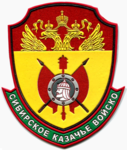
|

|
| Airforce | 
|

|
| Homeguard | 
|

|
| Dnieguan Navy | File:Marska polk.png | 
|
| Dnieguan Naval Aviation | 
|

|
| Naval Infantry | File:Naval Infantry Patch.png | 
|
| Dnieguan Rangers | 
|
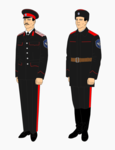
|
Service Uniforms
Personal Protection and Equipment
| Clothing | |||
|---|---|---|---|
| m/1-04 Skarvt | Under shirt | 100% Cotton olive drab shirt, to be worn on PT duty and in relaxed service settings. | File:M1a1 shirt.jpg |
| m/81 Underpartghervoden | Underwear | Boxer/breif style undergarment for all-season wear | File:Undervear.jpg |
| m/81 Skok | Socks | Socks | File:M41 skok.jpg |
| m/81 Oustervalpart | Shorts | PT Shorts | File:Jollygreens.jpg |
| Helmets | |||
| Faldshalhelm m/48 | Steel helmet | The Faldshalhelm m/84 (FsH m/48) was the standard Dnieguan military helmet from 1948 until its replacement by the m/84 series starting in 1982. It stil sees service with reserve components and homeguards troops, mostly in a flat white or green. | 
|
| Faldkermpundhelm m/84 | Kevlar helmet | The FkH m/84 series replaced the older m/48 series starting in 1982. Composed of mostly high-impact plastics and Kevlar molded around a steel cap, the light weight and high protection level make it generally superior to the older m/48. Current issue is the m/84-08, and updated version made of a more advanced material. | 
|
| Faldkermpundhelm m/84B | Kevlar vehicle crew helmet | A version of the FkH m/84 developed in the late 80s for vehicle crew. Includes flip down goggles and integrated communications. These helmets are issued to armor and ship crewmen, but is absent from helicopter crewmen; for these, the FkH m/84Fyl is issued. These helmets sacrifice protection for utility, weighing 200 grams more due to integrated equipment. | File:M84b.jpg |
| Protective Vests | |||
| Korpespskydd m/10 | Protective outerwear vest | Level III rated personal body armor offering full body protection from small arms fire up to 10 grams at a velocity of 850m/s and stabbing devices up to KR II. Inserts for small arm plates present. Issue started in 2010 to standard troops. These vests are heavier than the older Korpespskydd m/89-02 and m/98-06 sets, which remain in service. | File:Korpespskydd m10.jpg |
| Korpespskydd m/04 | Protective outerwear vest | Level IIIB rated vest with expansion for trauma plates present. Small steel lining protects against some attacks with stabbing weapons, but is not reliable. Issued mostly to heavy infantry; replacment begain in 2008 with intoruction of what would become the m/10 series. | File:Korpespskydd m04.jpg |
| Korpespskydd m/98 | Protective outerwear vest | Level IIB rated vest with inserts for trauma plates. Lightweight at 4.5kg/10kg with two plates inserted or 12.2kg with groin protector, this is the standard upper body armor protection for most Dnieguan troops. | File:Korpespskydd m98.png |
| Korpespskydd m/89 | Protective outerwear vest | Multi-level ballistic vest that offers limited protection against pistol calibers. Plate inserts offer expanded protection capabilities. Total weight 8.5 kilograms, 11.2 with ESAPI plate | File:Korpespskydd m89.png |
| Flytnaskvarkorpespskydd m/06 | Protective outerwear vest and flotation device | Multirole protective vest for rotor wing aviation and watercraft crewmen with survival flotation device built into neck. | File:Fytksk m06.png |
| Load Bearing Equipment | |||
| Stridsväst m/98 | Loadbearing webbing equipment | Soldiers webbing, with space for 8 magazines, 2.5 hydration bladder, flashlight, grenade pouch, LED and IR indicators, radio and others. Replaced the older Strvat m/72. | File:Stridsväst m98.jpg |
| Stridsväst m/72 | Loadbearing webbing equipment | Older webbing set with facilities for 8 magazines, grenades, flashlight and canteene. Still in use with homeguard units. | 
|
| Stridssäck m/98 | Assault pack | 35L capacity nylon pack, standard issue to all branches for stowage of necessary items. | File:Ss2000.jpg |
| Electronics | |||
| Bildföizstärkanre GN m/01 | Image Intensifiers | Current issue Gen. III Night Vision binoculars and image intensifiers, being upgraded to GN m/01-11 (m/1³). | File:GN m01.jpg |
| Bildförstärkare GN m/84 | Image Intensifiers | Current reserve and Homeguard issued Gen. II improved image intensifying goggles. standard issue until 2004, these wetre upgraded 2006-2008 to the GN m/84-06 standard, and are given to members of the Homeguard. | File:GN m84.jpg |
| Bildföizstärkanreoptikikh CV m/10 | Image intensifying Scope | Platoon leader issued thermal optic offering a 2x optical zoom with ability to identify man size targets at 600m. These scopes are also found at the Company level with attached reconnaissance units, where applicable. | File:CV m10.png |
| Bildföizstärkanremagnät GR m/08 | Image intensifying clip on | Allows daytime scope usage with night vision clip on attachment. | File:Gr m08.jpg |
| Rosniyföizstärkoptikikh CV m/01 | Red Dot optic | 2.4x28mm magnifiying red dot optic produced by Aimpoint, AB for the Dnieguan armed forces. Standard issue on the AG4 and AG3 rifles. | 
|
| CBRN protection | |||
| Skyddsgermask m/94 | Chemical/biological protective mask | The SG m/94 was designed to address shortcomings of the SG m/72 mask, including a narrow vision cone and lack of peripheral vision. The SG m/94 is less restrictive than the SG m/72 in most regards. Filters, voice amplifiers, and water intake tubes are common between the two. | 
|
| Skyddsgermask m/72 | Chemical/biological protective mask | the SG m/72 was the first truly modern CBRN protective mask adopted en mass for the Dnieguan Armed forces. Composed of Flexible rubber, the mask utilizes an Activated charcoal filter, which greatly improves safety. | 
|
| Avtominyektor m/70 | Autoinjector | Autoinjector for use on individuals when exposed to CBRN hazards. | 
|
| m/74 Foldkamzertkorpesvarn | CBRN protection suit | Smock and outerwear for protection against CBRN threats, includes jacket, boots, smock and gloves. | 
|
Munitions
| Name | Roles | Branches | Notes | Picture | |||
|---|---|---|---|---|---|---|---|
| Cartridges and Shells | |||||||
| 5.65x48mm SKU | Assault Rifles and Carbines, Machine Guns | All branches | Standard cartridge across all Skandar states. Adopted in 1984 with the adoption of the AG-4 rifle. | File:5.65mm SKU.jpg | |||
| 9x23mm | Pistols and Submachineguns | All branches | Service pistol round adopted in 1981 | 
| |||
| 6.5x55mm | Machine Guns, Marksman Rifles, Service rifles | All branches | Standard infantry cartridge from 1898-1984 over 6 different versions. Current standard is the m/52 langsver skarp patron | 
| |||
| 7.5x65mm | Machine Guns and sniper rifles | Homeguard, Army | Mostly in reserve but found on some helicopter Machine Guns, in use since 1932 | 
| |||
| 9.3x70mm SK | Machine Guns, Sniper rifles | All branches | Used in Medium-weight machine guns and special purpose sniper rifles. | File:9.3x70.jpg | |||
| 15.5x110mm | Heavy Machine guns, Anti-material Rifles | All branches | Used in HEavy Machine Guns and AMRs | 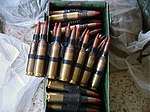
| |||
| 20x139mm | Automatic Cannons | All branches | In use in rotary cannons cor CIWS duties and CRAM systems, armament subset on aircraft | File:20x139mm.JPG | |||
| 25x137mm | Automatic cannons | All branches | In use in rotary cannons cor CIWS duties and CRAM systems, armament subset on aircraft | 
| |||
| 28x152mmB | Automatic Cannons | All branches | Armament subsystem on land vehicles and some ships; aircraft. | File:28x152mm.jpg | |||
| 37x192mmSR | Automatic Cannons | All branches | Used on dual purpose guns | File:37mm antimech.png | |||
| 40×364mmR | Automatic Cannons | All branches | Sees extensive service in a wide variety of roles. | File:40mm bofors.jpg | |||
| 57x438mm | Dual-purpose guns | Navy | In use on surface ships as a dual purpose gun for engagement of shore targets, small craft, and incoming aircraft. | File:57mmb.jpg | |||
| 76x636mmR | Dual-purpose gun | Navy | In use on surface ships as a dual purpose gun for engagement of shore targets, surface craft, and incoming aircraft. | 
| |||
| 90mm m/68 | Tank and Anti-tank ammunition Deck ammunition |
All branches | Used in a wide range of roles, principally for light tanks | 150px | |||
| 12cm m/81 | Tank gun | Army, Navy, Naval Infantry, Homeguard | Ammunition for the Tarskvagn-124 | 
| |||
| 12.7cm m/56 | Surface gun | Navy | For shore bombardment, anti-surface use | File:12cm.jpg | |||
| 145mm m/86 | Tank gun | Army, Homeguard, Naval Infantry | Primary armament on Tarskvagn-141 | 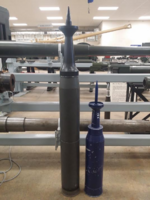
| |||
| Mortars and Rockets | |||||||
| 51mm Bomb | Light mortar | Army, Homeguard, Naval Infantry | In use in platoon-issued 51mm individual mortars | 
| |||
| 60mm Bomb | Mortar | Army, Navy, Homeguard | Mortar carriers and light infantry company level mortar | 
| |||
| 81mm Bomb | Mortar | All branches | Company-level mortar, mortar carriers, small craft | 
| |||
| 120mm Bomb | Heavy Mortar | All branches | Company and Battalion level mortar, Bombardment. | 
| |||
| Guided Munitions | |||||||
Weapons
| Name | Type | Caliber | Branches | Country of Origin | Description | Picture |
|---|---|---|---|---|---|---|
| Small arms | ||||||
| AG4 | Assault rifle | 5.65x48mm | Army, Air force, Naval Infantry, Navy, Homeguard | Standard issue service rifle of the Dnieguan Armed Forces since 1986 | 
| |
| R64E1 | Assault Rifle | 5.76/3.2x50mm | Naval Infantry, Air Force | Advanced Flechette rifle in use with special forces. | File:R64E1A1.gif | |
| AG-3 | Battlerifle/Designated Marksman Rifle | 6.5x55mm | Army, Naval Infantry, Navy, Homeguard | Officially phased out of service in 1994 as standard infantry rifle, now used in reserve units and used as a DMR. Standard issue rifle of many Law Enforcement and Homeguard units | ||
| PgK-80 | Semi-Automatic Pistol | 9x22mm Dnieguan | Army, Air Force, Naval Infantry, Navy, Homeguard | Issued to personnel who are non-combat arms and may require a lighter, more compact weapon other than a Carbine. | 
| |
| AkP m/98 | Personal Defense Weapon | 6.5x25 m/98 | Army, Air Force, Naval Infantry, Navy, Homeguard | Personal Defense Weapon, issued to helicopter troops, light infantry, marine boat crews and other roles in which a compact, lightweight weapon is necessary. | 
| |
| PkSVg-86 | Sniper Rifle | 8.6x86mm | Army, Air Force, Naval Infantry, Navy, Homeguard | Standard company-level sniper rifle. | 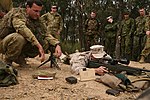
| |
| APG90 | Anti-Material Rifle | 12.7x115mm | Army, Airforce, Navy, Naval Infantry | Dniegua | Used by Snipers and Material Disposal units. | File:AG90.jpg |
| PkSVg-55 | Designated Marksman Rifle | 6.5x55mm | Homeguard, Army | Being phased out in standard use, now used by special Marksmanship units. | File:PkSVg-55.jpg | |
| KsP-58 | General-Purpose Machine Gun | 6.5x55mm | Homeguard, Army, Navy, Airforce, Naval Infantry | Standard Machinegun of Dnieguan Armed Forces since 1958 | File:Ksp58 1.jpg | |
| Let Støttevåben M/64 | Infantry Automatic Rifle | 5.65x48mm | Homeguard, Army, Navy, Airforce, Naval Infantry | Standard Infantry Automatic Rifle of the Dnieguan Armed Forces | ||
| Förstärkningsvapen 18 | Shotgun | 12 Gauge | Homeguard, Army, Navy, Airforce, Naval Infantry | 12 issued to Companies. | 
| |
| TkSP M/39 | Heavy Machinegun | 12.7mm | Homeguard, Army, Navy, Airforce, Naval Infantry | Employed in static defenses and on light vehicles. | 
| |
| Launchers and Projectors | ||||||
| 37mm Anti-Mechanization Weapon | Infantry Autocannon | 37x192mmSR | Army, Air force, Naval Infantry, Navy, Homeguard | Old as Fuck | File:IfK-37.jpg | |
| M26 Lightweight Infantry Autocannon | Infantry Autocannon | 25x60mmB | Army, Air force, Naval Infantry, Navy, Homeguard | Cool as Fuck | 
| |
| Rtkh M/48 | Recoilless rifle | 84x246mmR | Army, Air force, Naval Infantry, Navy, Homeguard | Also known as Gutsache, Karal G, Gustav Gorzkia, Tarnksmotazik or Trovsrappen | 
| |
| GvSkott 40mm | Underslung Grenade Launcher | 40mm Caseless | Army, Air force, Naval Infantry, Navy, Homeguard | File:GL-40.jpg | ||
| TsRb-84 | Anti-Tank Projector | 150mm ATGM | Army, Air force, Naval Infantry, Navy, Homeguard | File:TsRb.jpg | ||
| RfyK-84 Elektro | MANPAD | 108mm | Army, Air force, Naval Infantry, Navy, Homeguard | File:RfyK-84 Elektro.jpg | ||
| TrSkott 12 M/74 | Disposable Anti-Tank launcher | 122mm | Army, Air force, Naval Infantry, Navy, Homeguard | 
| ||
| PlySkott. M/94 | Reloadable anti-fortification launcher | 66mm | Army, Navy, Air Force, Naval Infantry, Homeguard | Template:Country data Estovnia | 
| |
| PlSP M/54 | Flamethrower | Effective fire range of 250m | Army, Naval Infantry, Homeguard | Being phased out, mostly used by Stormpionjärer | File:PLSP Flame in use.jpg | |
| Mortars | ||||||
| GrWpl M/84 | Commando Mortar | 51mm Mortar | Army, Naval Infantry, Homeguard | File:M84 Individual Mortar.jpg | ||
| GrWfT M/82 | Mortar | 82mm Mortar | Army, Air Force, Navy, Naval Infantry, Homeguard | 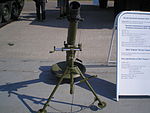
| ||
| GrWfT M/72 | Heavy Mortar | 120mm | Army, Air Force, Navy, Naval Infantry, Homeguard | 
| ||
Vehicles
| Name | Number | Caliber | Branches | Country of Origin | Uses | Notes | Picture |
|---|---|---|---|---|---|---|---|
| Haglunds Okan m/84 40mm autocannon | Over 6,000 | 40x364mmR | Army, Airforce, Navy, Naval Infantry, Homeguard | Template:Country data Estovnia |
|
Produced domestically as Tvkan m/48 | 
|
| TvKan m/64 | Over 8,000 | 37x225mm | Army, Airforce, Navy, Naval Infantry, Homeguard |
|
File:37mmAM TvK.jpg | ||
| TsKan m/211 | About 250 | 50x225mm (Cased Telescopic Ammunition) | Army, Navy |
|
File:50mm TsKann Mod 211.jpg | ||
| FlyKan m/201 | 1,800 | 28x152mmB | Army, Navy, Airforce, Naval Infantry, Homeguard |
|
Derived from Estovnian designs | 
| |
| FyRtEtKan m/94 | 1,150 | 25x137mm | Airforce, Army, Navy, Naval Infantry |
|
FyRtEtYKan- Flyemaviagptlan Rtyorri Yakash Elektronyago Kannon; literally "Aircraft Electronic Drive Rotary Cannon" | File:RtEtKan mod. 94.jpg | |
| FyRtEkKsp m/86 | 800 | 12.7x115mm | Airforce, Army, Navy, Naval Infantry, Homeguard |
|
FyRtEkYKsp: Flyemaviagptlan Rtyorri Elektronyago Yakash Kulspruta, literally "Aircraft Electronic Drive Rotary Machinegun" | File:FyRtEkKsp mod 86.jpg |
| Name | Role | Versions | Number | Branches | Country of Origin | Notes | Picture |
|---|---|---|---|---|---|---|---|
| Main Battle Tank | |||||||
| Tarskvagn-141 |
Main Battle Tank Combat Engineering Vehicle Armored Recovery Vehicle |
TsVg-141 Pnyortarskvagn 4 Kodlak Bgvp 14 |
1,728 | Army, Naval Infantry | In use with Armored units | File:Tsvgk.jpg | |
| Tarskvagn-124 | Main Battle Tank Combat Engineering Vehicle Armored Recovery Vehicle |
TsVg 124 Pnyortarskvagn 3 Bgvp 12 |
2,684 (93 in service with Homeguard units) | Army, Naval Infantry, Homeguard | In use with Infantry units | 
| |
| Infantry Fighting Vehicles | |||||||
| IpTKVg-90/41 | Infantry Fighting Vehicle SPAAG Light Tank Reconnaissance Vehicle Mortar Carrier |
TpKVg-90/41 FyKVg-90/37-2 StTpKVg-90/120 OvKVg-90/41 GrTpBgv-90/120R |
5,274 | Army, Naval Infantry, Navy, Airforce, Homeguard | Template:Country data Estovnia |

| |
| TrIVg m/62 | Infantry Fighting Vehicle SIGINT Vehicle Medical Vehicle Missile Carrier |
TrIvG m/62E2 EkTgVg m/86 MBVg-TI FyRbVg m/62 TrRbVg m/62 |
562 | Army, Navy, Airforce, Homeguard | Being phased out | 
| |
| Light Tank | |||||||
| IpKVG-91 | Light Tank/Tank Destroyer | IpKVG-91E1 | 262 | Army, Naval Infantry | 
| ||
| Anti-Aircraft systems | |||||||
| TAflyKVg M/70 | Self-propelled Anti-Aircraft gun | M/70-84 M/70-96 M70-210 |
About 1,000 | Army, Airforce, Navy, Naval Infantry | 
| ||
| IpFlyKvg m/94 | Self-Propelled Anti-Aircraft gun/Infantry carrier | m/94E1 | About 450 | Army, Naval Infantry, Airforce, Homeguard | Based on the IpTKVg-90/41 | 
| |
| Fykl-RBSgv m/204 | Short/Medium range Anti-Aircraft Missile | ~600 | Army, Airforce, Navy, Naval Infantry, Homeguard | Land/sea based RBS-23 system | File:RBS-23E.jpg | ||
| Armored Personnel Carriers and Troop Caries | |||||||
| IfPV m/82 | Wheeled IFV | 4x6 6x6 8x8 10x10 |
5,420 | Army, Airforce, Navy, Naval Infantry, Homeguard | Many versions | 
| |
| KG-Vagn | Wheeled Vehicle | 4x4 6x6 |
146,000 | Army, Airforce, Navy, Naval Infantry, Homeguard | Many versions | 
| |
| TKgIf m/212 | Armored Car/MRAP | 4x4 7 man 4x4 9 man |
862 | Airforce, Naval Infantry | 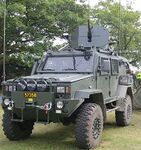
| ||
| TsIBV | Tracked Articulating AFV | Many | 6,200 | Army, Airforce, Navy, Naval Infantry, Homeguard | 
| ||
| Logistic Vehicles | |||||||
| Unimog | Multipurpose wheeled Logistic Vehicle | Many | 8,900 | Army, Navy, Airforce, Naval Infantry, Homeguard | 
| ||
| ItVg m/67 | Logistic support Vehicle and Prime Mover | 16,500 | Army, Navy, Air Force, Homeguard | 
| |||
| Reto | Multipurpose wheeled vehicle | 4,500 | Army, Navy, Airforce, Homeguard | 
| |||
| Self Propelled Artillery | |||||||
| Skan-1 | Self Propelled Howitzer | Skan-1 SKan-1B SKan-1 SKan-2 |
384 | Army, Naval Infantry | 
| ||
| RvKan-1 | Self-Propelled Gun | RvKan-1A RvKan-1B RVkan-1C RVKan-L |
252 | Army, Navy, Naval Infantry | Mounted on some landing ships for shore bombardment | File:Yeoman-B.JPG | |
| RMOS | Self-Propelled Automatic Mortar System | TsRGv VgRGv SRGFv (naval) |
350 | Army, Navy, Naval Infantry | File:RMOS on 90-4 chassis.png | ||
| VgMGV m/206 | Mortar Carrier | M/206 | 675 | Army | 
| ||
| RkTVg M/89 | Multiple Launched Rocket system | M/89-210 | 372 | Army, Naval Infantry, Navy | 
| ||
Aircraft
| Name | Description | Branches | Version | Quantity | Notes | Picture |
|---|---|---|---|---|---|---|
| Close air support | ||||||
| IkB-37 | All Weather Close Air Support Fighter-Bomber | Naval Aviation Air Force |
IkB-37A IkB-37D IkB-37E |
112 112 98 |
File:IkB-37 Three View.png | |
| Fighter Aircraft | ||||||
| RfA-39 Gripen | Multirole Fighter Aircraft | Naval Aviation Airforce Homeguard |
RfA-39A RfA-39B RfA-39C RfA-39D RfA-39E2 RfA-39N |
0 0 126 156 28 112 |

| |
| SKAR-349 | Air Superiority fighter | Naval Aviation Airforce |
SKAR-349B SKAR-349C SKAR-349V SKAN-349V2 |
168 | File:SKA Retaliator.png | |
| Strategic Bombers | ||||||
| NkB-78 | Supersonic Low-Observable Strategic Heavy Bomber | Naval Aviation Airforce |
NkB-78D NkB-78M |
70 48 |
File:NkB.png | |
| Cargo Aircraft | ||||||
| TFyL-235 | Medium Cargo Transport | Naval Aviation Airforce |
TFyL-235/300 TFyL-235/300 |
40 | 
| |
| RTFyL-378 | Heavy Cargo Transport | Airforce | 24 | 
| ||
| TFyL-044 | Tactical Transport Aircraft | Airforce Naval Aviation |
TFyL-044D TFyL-044R TFyL-044M |
56 | 
| |
| MRTFyL-80 | Strategic Airlifter | Airforce | 38 | 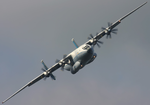
| ||
| TFyL-115 | Medium Transport/Gunship | Airforce Naval Aviation |
RkTFyL-115 Okan | 24 | 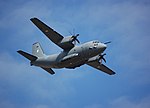
| |
| TfyL-160 | Tactical Transport | Airforce Naval Aviation Homeguard |
80 | 
| ||
| Dassault Falcon 900 | VIP Transport | Airforce Homeguard |
8 | 
| ||
| Airbus A340 | VIP Transport | Airforce | 4 | |||
| Special Missions Aircraft | ||||||
| EkRSFY M/206 Argus | Airborne Warning and Control | Airforce | 8 | File:RfA-39 and M-206 Argus.jpg | ||
| NEkRFY m/93 Ikpin | Naval AEWACS | Naval Aviation | 6 | File:Carrier AWACS.png | ||
| APrFyL-111 Yevnir | Ariel Tanker | Airforce | 4 | 
| ||
| APrFyL-96 Kubik | Ariel Tanker | Airforce Naval Aviation |
8 | 
| ||
| VsKFyL-202 | Maritime Patrol | Airforce Naval Aviation |
20 | 
| ||
| KVFyL-228 | Observation/S&R | Naval Aviation | 40 | 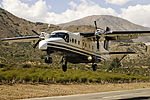
| ||
| Trainers | ||||||
| DVA-20R | Light training aircraft | Airforce Army Aviation Naval Aviation Homeguard |
72 | Also used as a flight aerobatics aircraft | 
| |
| KVA-45R | Turboprop Trainer | Airforce Naval Aviation Homeguard |
48 | May also be used in ground attack roles | 
| |
| LKV-106 | Advanced jet trainer/LIFT | Aiforce Naval Aviation Army Aviation Homeguard |
36 | Also used as a light strike aircraft | 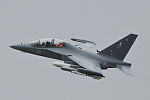
| |
| LVI-440 | Multi-engine trainer | Airforce Naval Aviation Homeguard |
16 | 
| ||
| UAVs | ||||||
| EYES Orca | U(C)AV | Airforce Naval Aviation Arrmy Aviation |
8 | 14 more on order | 
| |
| AV-2 Vojka | UCAV | Naval Aviation | 24 for testing | More properly a controlled missile, homes in on radar signals and destroys itself and the source with a 42 kilogram HE Warhead | 
| |
| VKFyL-202 | UAV | Airfoce Army Navy Naval Infantry |
100+ | 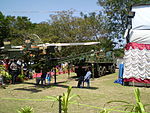
| ||
| RtkF-76 | Rocket surveillance UAV | Navy Army Naval Infantry Homeguard |
TRVTRK (Fire watch) | ~700 | 
| |
| TRV m/215 | Cargo UAV | Army Navy |
16 | Can carry 275kg of cargo | File:TRV-215 UAV.jpg | |
| TRV m/206 | ESM/Recon UAV | Army Airforce |
28 | 
| ||
| Name | Type | Variations | Branches | Number | Notes | Picture |
|---|---|---|---|---|---|---|
| Attack Helicopters | ||||||
| V-256 Sagoska | Attack Helicopter Armed Scout helicopter Stealth Helicopter |
V-256R V-256E V-256M LV-256 OV-256D |
Airforce Army Aviation Naval Aviation Homeguard (OV-256) |
42 294 168 28 |
File:Dnieguan Army Sagoska-2.jpg | |
| V-232 Snypera | Scout/Observation Attack Helicopter | V-232A V-232R V-232E |
Airfoce Army Aviation Naval Aviation |
84 182 56 |
File:V-232 Snypera.jpg | |
| Multirole Helicopters | ||||||
| V-263 Tromp | Multirole Armed Transport Helicopter | Army Aviation Naval Aviation |
94 128 |
File:V-263 Tromp.jpg | ||
| LRH-86 | Multirole Helicopter | LRO-86 LRH-86E ARH-86 |
Airforce Army Aviation Naval Aviation Homeguard |
132 80 80 240 |

| |
| Cargo and Transport Helicopters | ||||||
| Vk-90 | Transport Helicopter | Vk-90-10 | Airforce Army Aviation Homeguard |
80 108 96 |

| |
| V-450 | Transport/Medium Lift Helicopter | V-450E | Airforce Army Aviation Naval Aviation Homeguard |
20 132 60 36 |
File:V-450.jpg | |
| V-107 | Medium lift/Transport Helicopter | Many | Naval Aviation Homeguard |
240 216 |
File:V107.png | |
| V-468 | Heavy lift helicopter | Many | Airforce Army Aviation Naval Aviation Homeguard |
40 240 180 24 |

| |
Ships in service
| Name | Type | Ships in Class | Displacement | Notes | Picture | |
|---|---|---|---|---|---|---|
| Surface Ships | ||||||
| Jutlund Class | Aircraft Carrier | Jutlund Yovlund |
68,000 tonnes | File:Jutlund class.jpg | ||
| Koyssyak class | Battle cruiser | Koyssyak Rimphiri 'Donya Urgalsi |
32,000 tonnes | File:Koyss. Class Battle Cruiser.png | ||
| Denphri class | Cruiser | Denphri Makalti Czekini Akova Kaltuva Dovva |
15,560 tonnes | 
| ||
| Yargan Class | Air Defense Cruiser | Yargan Voyska Yevnal Orstrad Gtoryid Jorgmund |
11,500 Tonnes | 
| ||
| Bulva Class | Guided Missile destroyer | Bulva Hkorm Troli Svotli Grvolsti Wyfee |
6,800 tonnes | 
| ||
| Shashka class | Multipurpose Stealth Destroyer | Shashka Yotov Nagaikot Gaziri Spyess Patronen Boyar |
7,650 tonnes | 
| ||
| Mathock class | Multipurpose stealth destroyer | Mathock Grabakr Varcolac Gryphus |
13,500 Tonnes | 6 more planned | File:805.jpg | |
| Prtanvolk class | Anti-surface warfare frigate | Prtanvolk Novia Inguish Maltova Urnasta Trongal Nurd Merklum |
7,200 tonnes | File:Krus.jpg | ||
| Skostal class | Anti-Aircraft Frigate | Skostal Ostergrod Froskol Ostong Klappe Handdong Grosvikk Stalmas Marsjon Taxkan Stornfrosin Vangel |
6,200 tonnes | 
| ||
| Danutaclass | Multipurpose light frigate | Vanarn Bjormal Veznustrmmy Gorka Vinderost Telmarch |
4,500 tonnes | File:File:AlRiyadh 6.jpg | ||




















